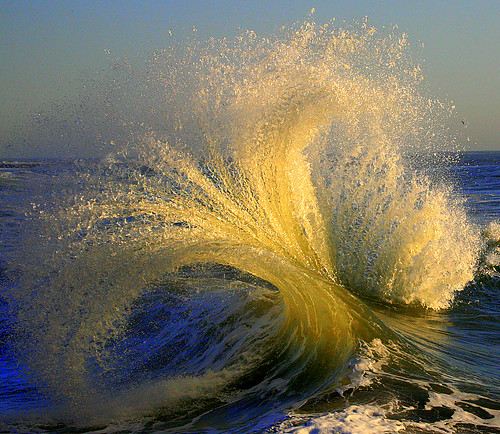Water, Water Everywhere (Except Here)

We’ve all heard about the ice samples found by the Phoenix Mars Lander on the surface of Mars.
For the past several weeks, the Martian dirt and ice have been clutched in the scoop of the Lander’s robotic arm, in a sort of scientific Butoh dance, while NASA engineers and scientists have figured out a way to get the sample into the Thermal and Evolved Gas Analyzer (TEGA) — AKA the "analysis ovens:"
TEGA… heat[s] Martian soil so that any gases emitted can be analyzed. On its first test in mid-June, the oven being used developed a short circuit. [NASA] scientists stalled any further TEGA analysis while they were studying the problem. And now they’ve halted planned tests and moved a test of Martian ice up to the front of the line, according to Ray Arvidson, a co-investigator for the Phoenix Mars Lander’s robotic arm team and a professor at Washington University in St. Louis.
"Because of the possibility, even the remote possibility, that TEGA might go belly-up in the next sample, we wanted to go straight to ice," said Arvidson. "We cleared the pathway to get the next sample from the ice. The prudent choice is to go off and get the most important sample."
Where did Mars’ water go, you ask?
The two most likely possibilities are that the water was lost to space, or that it is now underground, as a huge amount of buried ice.
But Mars isn’t the only place in the solar system where evidence of water has (possibly) been found; a study published today in Nature reveals that researchers have found evidence of water molecules in pebbles retrieved by NASA’s Apollo missions on the moon, nearly forty years ago:
Erik Hauri of the Carnegie Institution for Science in Washington had developed a technique called secondary ion mass spectrometry or SIMS, which could detect minute amounts of elements in samples. His team was using it to find evidence of water in the Earth’s molten mantle.
"Then one day I said, ‘Look, why don’t we go and try it on the moon glass?"’ Alberto Saal of Brown University, who helped lead the study, said in a telephone interview….
What they found overturned the conventional wisdom that the moon is dry.
"For 40 years people have tried (to find evidence of water) and were not successful," Saal said.
"Common sense tell us there is nothing."
Saal’s team did not find water directly, but they did measure hydrogen, and it resembled the measurements they have done to detect hydrogen, and eventually water, in samples from Earth’s mantle.
The evidence shows that the hydrogen in the sample vaporized during volcanic activity that would be similar to lava spurts seen on Earth today.
It took the scientists nearly three years to get NASA to fund their project. The findings point to the existence of water deep beneath the moon’s surface — a radical change in the scientific understanding of our moon’s formation.
The pebbles analyzed were scattered by lunar volcanoes that erupted three billion years ago, when the moon was still a cooling hunk of magma cast into orbit by the collision of a Mars-sized asteroid with Earth, according to ABC News:
Though NASA’s Lunar Prospector appeared to have struck ice in 1999, its findings proved inconclusive. Had they been supported, scientists predicted that any water would have come from gases emitted by meteorites striking the moon….
Critically, telltale hydrogen molecules were concentrated at the center of samples rather than their surfaces, assuring Saal’s team that water was present in an infant moon rather than added by recent bombardment.
"That was not known," said William Feldman, a Los Alamos National Laboratory geophysicist who was not involved in the study.
If that water in fact came from the Earth, then planetary geologists can be certain that our planet contained water 4.5 billion years ago. That would change the dynamics of models of Earth’s formations….
Alternatively, water could have been added after the moon was ejected into space but before it cooled, raising new questions about the water’s origin.
"This opens up so many lines of study," said Saal.
More practically, the widespread presence of water beneath the moon’s surface could prove a boon to future lunar colonies, who could harvest it for breathable oxygen
Meanwhile, here on Earth, potable water is increasingly under short supply as droughts and population growth put a strain on our own water resources.
The solution increasingly is desalination plants, particularly in the Middle East, where the amount of fresh water available to each person could fall by half by 2050:
The UAE and other Gulf countries have traditionally responded to water scarcity by boosting desalination capacity. Most of the potable water in the region is produced via desalination, a process in which dissolved salts are removed from seawater.
However, earlier this year a UN official warned that GCC countries would find it increasingly difficult to continue building desalination plants at the current rate.
The region’s water consumption was so high that continuing in the same way would require significant financial investments and might prove impossible to sustain, said Dr Ahmad Ali Ghosn, the natural resources programme officer at the UN Environment Programme.
In Abu Dhabi, residents consume an average of 550 litres of water per day. If consumption levels remained this high, Gulf governments would have to spend up to US$35 billion (Dh129bn) in the next decade to finance the expansion of their desalination capacity.
In addition, water is heavily subsidised in the region, with end-users paying between five and 10 per cent of the cost. The UN estimates that GCC countries spend between US$1 and US$2 to produce a cubic metre of desalinated water.
Desalination unfortunately has several adverse effects on the environment. It is a very energy-intensive process, with desalination plants releasing large amounts of carbon dioxide into the atmosphere, which contributes to global warming.
Perhaps a water pipeline from the moon is in our future?